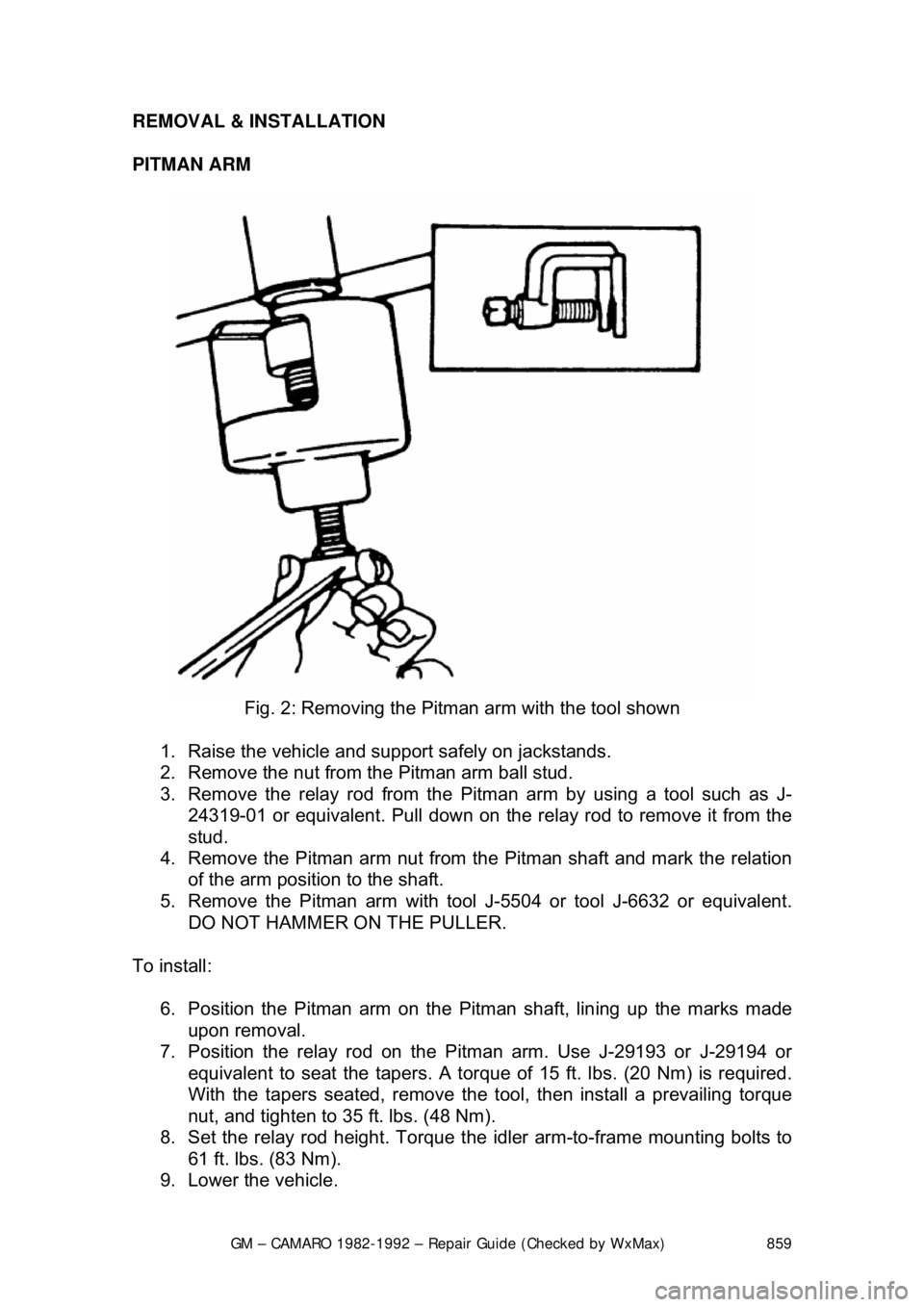Page 572 of 875
GM – CAMARO 1982-1992 – Repair Guide (Checked by WxMax) 572
9. Connect all electrical, vacuum and f
uel connection to the carburetor.
10. Install the air cleaner and connec t the negative battery cable.
Fig. 2: Electric EFE heater assembly
ELECTRIC EFE RELAY 1. Disconnect the negative battery cable.
2. Remove the retaining bracket.
3. Tag and disconnect all el ectrical connections.
4. Unscrew the retaining bolts and remove the relay.
To install: 5. Position the relay into place and secu re the relay with the retaining bolt.
6. Attach all electrical connections.
Page 589 of 875
GM – CAMARO 1982-1992 – Repair Guide (Checked by WxMax) 589
Fig. 3: On some models, the IAT sens or may be located on the air intake hose
THROTTLE POSITION SENSOR (TPS)
OPERATION
The TPS is mounted to the throttle body, opposite the throttle lever and is
connected to the throttle shaft. Its functi on is to sense the current throttle valve
position and relay that information to the ECM. Throttle position information
allows the ECM to generate the required injector control signals. The TPS
consists of a potentiometer which alters the flow of voltage according to the
position of a wiper on the variable resi stor windings, in proportion to the
movement of the throttle shaft.
Page 739 of 875

GM – CAMARO 1982-1992 – Repair Guide (Checked by WxMax) 739
3. Make sure the ignition switch has
been in the OFF position for at least 10
seconds and that all accessories are OFF.
4. Turn the ignition switch ON and the pump will run for about 2 seconds.
Note the system pressure with t he pump running, it should be between
40-47 psi.
The ignition switch may have to be cycled to the ON position more than once to
obtain maximum pressure. It is also norma l for the pressure to drop slightly
when the pump first stops, but it should then hold steady.
5. If the pressure is not as specified, verify that fuel pump operation is
heard in the tank.
6. If fuel pump operation is not heard, inspect the fuel pump relay and
wiring.
7. If fuel pump operation is heard, inspect the filter and lines for restriction.
8. Start the engine and make sure the pr essure decreases about 3-10 psi at
idle.
9. If fuel pressure does not decrease, inspect the fuel pressure regulator
and hose.
10. Disconnect the fuel pressure gauge.
THROTTLE BODY
REMOVAL & INSTALLATION 1. Disconnect the negative (-) battery c able and partially drain the radiator.
2. Remove the air inlet duct and unplug the IAC and TPS electrical connectors.
3. Label and disconnect the vacuum and coolant lines.
4. Disconnect the accelerator, thro ttle valve (transmission control) and
cruise control cables, as applicable.
5. Remove the throttle body attaching bolts, then separate the throttle body from the plenum.
6. Discard the gasket.
To install: 7. Install the throttle body to the plenum using a new gasket. Tighten the \
bolts to specification.
8. Engage the accelerator, throttle valve and cruise control cables, as
necessary. Make sure that the link ages do not hold the throttle open.
9. Connect the vacuum and coolant lines.
10. Install the air inlet duct and plug the IAC and TPS electrical connectors
into their sockets.
11. Connect the negative (-) battery cable and refill the radiator.
12. With the engine OFF, check to s ee that the accelerator pedal is free.
Depress the pedal to the floor and release.
Page 859 of 875

GM – CAMARO 1982-1992 – Repair Guide (Checked by WxMax) 859
REMOVAL & INSTALLATION
PITMAN ARM
Fig. 2: Removing the Pitman arm with the tool shown
1. Raise the vehicle and support safely on jackstands.
2. Remove the nut from the Pitman arm ball stud.
3. Remove the relay rod from the Pitman arm by us ing a tool such as J-
24319-01 or equivalent. Pull down on the relay rod to remove it from the
stud.
4. Remove the Pitman arm nut from the Pitman shaft and mark the relation
of the arm position to the shaft.
5. Remove the Pitman arm with tool J-5504 or tool J-6632 or equivalent.
DO NOT HAMMER ON THE PULLER.
To install: 6. Position the Pitman arm on the Pitman shaft, lin ing up the marks made
upon removal.
7. Position the relay rod on the Pi tman arm. Use J-29193 or J-29194 or
equivalent to seat the t apers. A torque of 15 ft. lb s. (20 Nm) is required.
With the tapers seated, remove the t ool, then install a prevailing torque
nut, and tighten to 35 ft. lbs. (48 Nm).
8. Set the relay rod height. Torque t he idler arm-to-frame mounting bolts to
61 ft. lbs. (83 Nm).
9. Lower the vehicle.
Page 860 of 875
GM – CAMARO 1982-1992 – Repair Guide (Checked by WxMax) 860
Idler Arm
1. Raise the vehicle and support safely on jackstands.
2. Remove the idler arm to fr ame nuts, washers, and bolts.
3. Remove the nut from the idle r arm to relay rod ball stud.
4. Remove the relay rod from t he idler arm by using J-24319-01 or
equivalent.
5. Remove the idler arm.
To install: 6. Position the idler arm on the fr ame and LOOSELY install the mounting
bolts, washers and nuts.
7. Install the relay rod to the idler a rm, making certain seal is on the stud.
Use J-29193 or J-29194 or equivalent to seat the tapers. A torque of 15
ft. lbs. (20 Nm) is required. With the tapers seated, remove the tool, then
install a prevailing torque nut, and ti ghten to 35 ft. lbs. (48 Nm).
8. Set the relay rod height. Torque t he idler arm-to-frame mounting bolts to
61 ft. lbs. (83 Nm).
9. Lower the vehicle.
RELAY ROD
Fig. 3: Removing the relay rod-to-tie rod nut
Page 861 of 875
GM – CAMARO 1982-1992 – Repair Guide (Checked by WxMax) 861
Fig. 4: Separating the tie rod from the relay rod using a gear puller
Fig. 5: Disconnecting the tie rod from the relay rod
Page 862 of 875

GM – CAMARO 1982-1992 – Repair Guide (Checked by WxMax) 862
During production, the installe
d position of the relay rod is carefully controlled to
assure that the rod is at the proper height. Both the left end and the right end of
the relay rod must be held at the sa me height. The side-to-side height is
controlled by adjusting the pos ition of the idler arm
Whenever disconnecting the rela y rod assembly, it is important to first scribe the
position of the idler arm-to-frame, and to reinstall the idler arm in the same
position. Be sure to prevent the idler support from turning in the bushing, since
that motion could result in improper relay rod height.
Whenever replacing the relay rod, or the idler arm, or the Pitman arm, it is
mandatory to establish the correct height.
1. Raise the vehicle and support safely on jackstands.
2. Remove the inner ends of the tie rods from the relay rod.
3. Remove the nut from the relay rod ball stud attachment at Pitman arm.
4. Detach the relay rod from the Pitm an arm by using tool such as J-24319-
01 or equivalent. Shift the steering lin kage as required to free the Pitman
arm from the relay rod.
5. Remove the nut from the idler arm and remove the relay rod from the
idler arm.
To install: 6. Install the relay rod to idler arm, ma king certain idler stud seal is in place.
Use J-29193 or J-29194 or equivalent to seat the tapers. A torque of 15
ft. lbs. (20 Nm) is required. With the tapers seated, remove the tool, then
install a prevailing torque nut, and ti ghten to 35 ft. lbs. (48 Nm).
7. Raise the end of the rod and insta ll on the Pitman arm. Use J-29193 or J-
29194 or equivalent to seat the tapers. A torque of 15 ft. lbs. (20 Nm) is
required. With the tapers seated, remove the tool, then install a prevailing
torque nut, and tighten to 35 ft. lbs. (48 Nm).
8. Install the tie rod ends to the re lay rod. Lubricate the tie rod ends.
9. Install the damper , if equipped.
10. Set the relay rod height. Torque t he idler arm-to-frame mounting bolts to
61 ft. lbs. (83 Nm).
11. Lower the vehicle.
12. Check and, if necessary, adjust front end alignment.
Page 863 of 875
GM – CAMARO 1982-1992 – Repair Guide (Checked by WxMax) 863
TIE ROD ENDS
Fig. 6: Using a tie rod removal tool
1. Raise the vehicle and support safely on jackstands.
2. Remove the cotter pins from the ball studs and remove the castellated
nuts.
3. Remove the outer ball stud by usi ng the ball stud puller. If necessary, pull
downward on the tie rod to disconnec t it from the steering arm.
4. Remove the inner ball stud from the relay rod using a similar procedure.
5. Remove the tie rod end or ends to be replaced by loosening the clamp
bolt and unscrewing them.
To install: 6. Lubricate tie rod threads with chassi s grease and install new tie rod(s).
Make sure both ends are an equal di stance from the tie rod and tighten
clamp bolts.
7. Make sure ball studs, tapered surf aces, and all threaded surfaces are
clean and smooth, and free of grease. Install seals on ball studs. Install
ball stud in steering arm and relay rod.